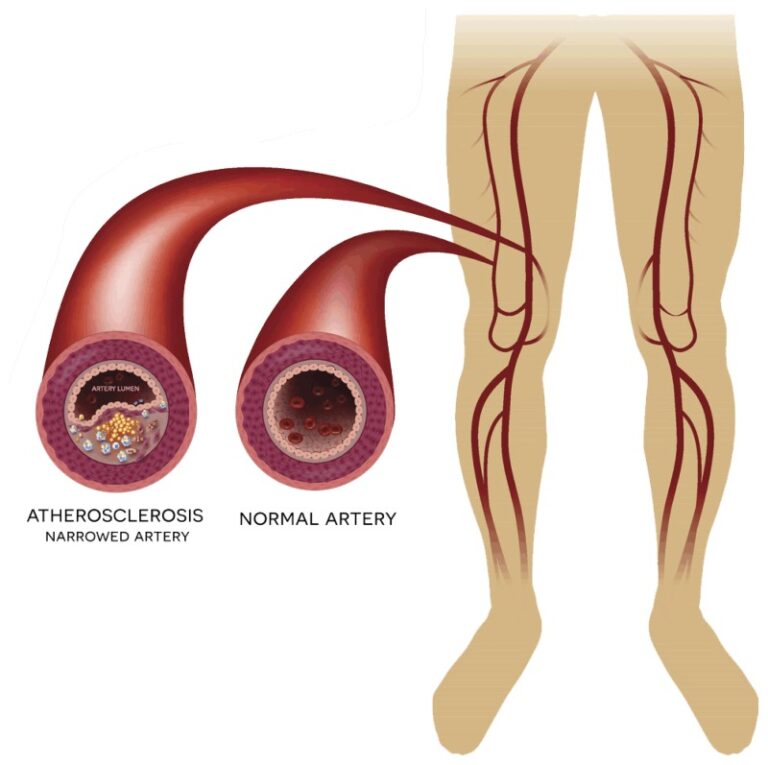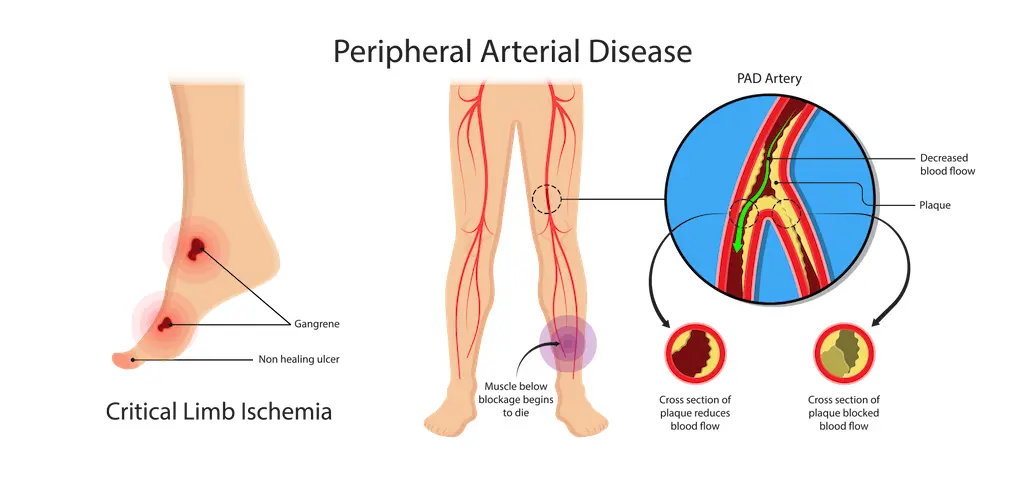Peripheral Artery disease treatment
Peripheral artery disease (PAD) is a condition in which the arteries that supply blood to the limbs, usually the legs, become narrowed, reducing blood flow. Treatment for PAD focuses on reducing symptoms and preventing further progression of the disease.

Peripheral Artery Disease (PAD) is a circulatory condition that occurs when the arteries in the limbs (usually the legs) become narrowed or blocked due to the buildup of fatty deposits (atherosclerosis). PAD can lead to reduced blood flow, causing symptoms like leg pain and increasing the risk of serious complications like limb amputation. Treatment for PAD aims to alleviate symptoms, improve circulation, and reduce the risk of complications. Here’s a detailed overview:
PAD (Peripheral Arterial Disease) is a condition that affects people above the age of fifty. In this condition, fatty deposits, cholesterol, calcium, etc., start accumulating inside the arteries in any part of the body. This disease mostly affects the arteries in the legs and hands.

1. Symptoms –
- Burning sensation in the legs
- Pain
- difficulty walking
- cold feet
- change in skin color
- ulcers on the feet
- gangrene

In this condition, we should get a color Doppler test done, after angiography f/b thrombolysis / ballon plasty.
The blood clots inside the arteries are broken down by going inside the arteries. When the arteries become narrow or blocked, we need to undergo angioplasty.
2. Lifestyle Modifications:
- Smoking Cessation
- Regular Exercise
- Healthy Diet
- Weight Management
- Blood Sugar Control

3. Medications:
- Antiplatelet Medications
- Cholesterol-Lowering Medications
- Blood Pressure Control
- Symptom Relief
4. Interventional Procedures:
- Angioplasty and Stenting Interventional radiologists have advanced angioplasty and stenting, which was previously used in the treatment of peripheral artery diseases. Using imaging for guidance, interventional radiologists inflate a balloon (Balloon Angioplasty) in blocked arteries to open them up. In some cases, this is done using a stent. This is a minimally invasive procedure that does not require surgery; only a small incision, about the size of a pencil tip, is made in the skin.
- Atherectomy Under this treatment, a small catheter is inserted into the artery at the blocked site, which cuts or shaves off plaque from inside the artery.
- Arterial Thrombolysis-Catheter directed intraarterial thrombolytic therapy, vascular specialists inject medication directly into the artery to dissolve clots that have formed in the artery due to blood clots. This will distribute clot-dissolving medications directly onto the thrombus, reducing the total dose required, lowering the risk of bleeding, and increasing the likelihood of artery opening.”

5. Wound Care: For individuals with ulcers or open sores, proper wound care and infection management are crucial to prevent complications.
6. Supportive Therapies:
- Hyperbaric Oxygen Therapy: In some cases, hyperbaric oxygen therapy may promote wound healing in individuals with non-healing ulcers.
7. Diabetes Management:
- For individuals with diabetes, strict blood sugar control is vital to reduce the risk of complications associated with PAD.
Are you at risk for PAD? Check here. The people most at risk for Peripheral Arterial Disease (PAD) are:
- Individuals over 50 years of age.
- Smokers.
- Diabetic patients.
- Those with higher than normal body weight.
- Inactive individuals (those who do not exercise).
- Individuals with high blood pressure and high cholesterol.
- Those with a family history of vascular diseases such as heart attacks or strokes.

The choice of treatment for PAD depends on the severity of the condition, the presence of symptoms, and the patient’s overall health. A multidisciplinary approach involving vascular specialists, cardiologists, and other healthcare professionals is often employed to tailor the treatment plan to the individual’s needs. Early diagnosis and intervention are essential to effectively manage PAD and reduce the risk of complications such as limb amputation.
Get One Step Ahead Of Disease
Imperdiet aliquet est vel nulla turpis eu consequat ullamcorper a egestas suspendisse faucibus eu velit, phasellus pulvinar lorem et libero et tortor, sapien nulla.
Subsribe To Our Newsletter
Stay in touch with us to get latest news and special offers.
Vascular Clinic
Shekhar Sarraf Memorial Hospital, Aligarh Vishal Imaging Centre, Aligarh
Call Us
+91-9548752611
Email Us
konikachaudhary8@gmail.com
